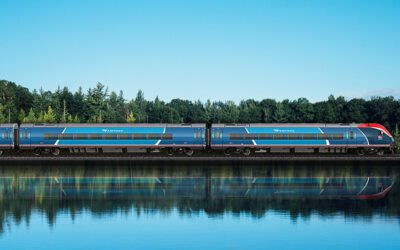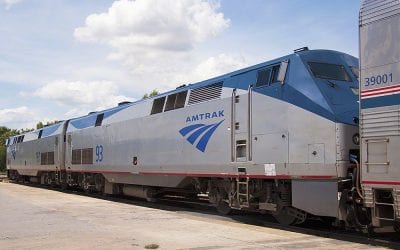On-time trains need cooperation with other types of trains using tracks across America.

Only last week, Amtrak for the first time gave each of the Class I freight railroads that host the majority of its trains a letter grade based on the number of minutes of host-caused delay per 10,000 train miles. The passenger carrier’s “Host Railroad Report Card & FAQ” gives failing grades to Norfolk Southern and Canadian National, a C grade to CSX, a B- to Union Pacific, a B+ to BNSF and an A to Canadian Pacific. The report excludes the handful of smaller regional freight railroads, state departments of transportation and public commuter rail authorities that also host Amtrak trains. Amtrak owns the tracks it uses between Washington, D.C., and Boston (except between New Rochelle, N.Y. and New Haven, Conn.), as well as New Haven to Springfield, Mass., Philadelphia to Harrisburg, Penn. and Porter, Ind., to Kalamazoo, Mich.
“An “F” host forces Amtrak trains on a particular route to wait one hour and 40 minutes on average for freight trains, and forces many Amtrak trains on this route to wait as long as 3 hours and 12 minutes,” the report reads. “As a comparison, suppose you were on a flight and your plane had to circle the destination airport for one hour and 40 minutes while cargo flights were given priority to use the runway.”
The report notes that the host railroads are “highly profitable” and that Amtrak pays them $142 million annually for use of their tracks and other resources needed to operate passenger trains. “Freight railroads suffer no significant consequences for prioritizing their freight over our country’s rail passengers,” Amtrak claims.
However, as longtime railroad industry observer Fred Frailey notes in his Trains Magazine blog column, “Union Pacific, CSX, Norfolk Southern and Canadian National are also the railroads in the news for being unable to keep their freight deliveries on time. As I’ve discovered time after time, passenger trains are the canary in the coal mine. When they cannot make their achievable schedules, it usually means the host railroad is also in a world of woe.”
Under the terms of the 1970 law that created Amtrak and relieved the private railroads (predecessors to today’s Class I’s) of the obligation to operate their own passenger trains, Amtrak is granted access to all the country’s standard-gauge private railroad tracks on an incremental cost basis. This means that Amtrak is only required to pay its hosts access fees equivalent to the marginal (additional) cost the host incurs by accommodating passenger trains, rather than the fully allocated cost the host may assign to Amtrak.
Also, under an amendment to the 1970 law that Congress passed in 1973, Amtrak trains are granted priority over freight trains “on any rail line, junction or crossing.” However, as Amtrak’s report notes, the only entity legally capable of acting against a host railroad that fails to give Amtrak priority is the U.S. Department of Justice, which has only exercised this prerogative once in Amtrak’s history (in the mid-1970s).
In 2008, Congress attempted to give Amtrak an additional remedy for on-time trains by requiring it and the U.S. Department of Transportation to jointly write performance standards for its trains that would be required to be incorporated into the passenger carrier’s agreements with its hosts. But in 2015, a federal appeals court struck down these metrics as an unconstitutional violation of the freight railroads’ right to due process because they gave Amtrak, which competes with freight trains for finite track capacity, a measure of regulatory power over its competitors, according to the court’s interpretation. While the court battle is ongoing, Congress has failed to take any further action that would help Amtrak trains run on-time in a way that passes constitutional muster.
While highway and air transportation are characterized by private carriers operating vehicles over publicly-owned infrastructure paid for, at least in part, by general tax dollars (roads, airports, and the air traffic control system), only in the passenger rail sector do we have a quasi-public carrier (Amtrak) operating trains over privately-owned infrastructure whose construction and maintenance is almost entirely privately financed.
While private passenger carriers are not prohibited from operating trains in competition with Amtrak — there are a number of firms capable of doing so, many of which already operate commuter trains under contract to government authorities — they have a number of legal and institutional hurdles to overcome. Meanwhile, Amtrak — a large, bureaucratic institution with a culture of resistance to change buffeted by multiple, competing political pressures — enjoys a de facto monopoly on intercity passenger transportation by train. For this reason, future laws and policies intended to help Amtrak run on-time trains should treat all passenger train operators equally and not privilege Amtrak over commuter railroads and others.
There are three divergent approaches to solving the on-time trains problem, each of which, or some combination of which, would likely bear more fruit than the status quo.
- One is for Congress to put some teeth behind the current passenger priority statute and allow any rail passenger carrier, or even passenger advocacy organizations, to bring complaints against host railroads before the Surface Transportation Board (an agency that is semi-independent from DOT and already exercises regulatory oversight over freight railroads in terms of their treatment of shippers) and allow the Board to assess penalties against host railroads found to be at fault for chronic delays.
- Another approach for on-time trains is for a combination of federal and state governments to give passenger carriers a pot of money, perhaps distributed on a ridership-based formula, that they can use to pay host railroads what the hosts might consider a fairer price for access to their track. One reason for host railroads’ poor treatment of Amtrak may be that they don’t see it as paying its fair share. Commuter railroads that use freight carriers’ tracks already pay more per train-mile than Amtrak does because they have to negotiate with hosts at arms’ length without the benefit of Amtrak’s right to incremental-cost access.
- The third on-time trains approach is simply to make greater investments in railroad infrastructure to ease bottlenecks and provide sufficient track capacity so that passenger and freight trains do not get in each others’ way and both have the opportunity to grow and thrive. Freight railroads, however, tend to resist accepting public money that comes with strings attached, and there is also opposition to spending public money on private infrastructure.
None of these on-time trains solutions will happen unless Congress hears loud and clear from their constituents that modernizing America’s passenger trains should be a greater priority, and that thoughtful and balanced legislation is needed to keep passenger trains running on-time. Our partners at the Rail Passengers Association are leading this fight, and there are many ways you can help.
The author of this post, in addition to working with Travelers United, also serves on the volunteer advisory body of the Rail Passengers Association and as a consultant to Herzog Transit Services, Inc., one of the private firms that is a contract operator of commuter rail and rail transit systems and is seeking to enter the intercity passenger rail market. He also writes for Trains Magazine.Magazine.

I am a writer, researcher, multimedia communications professional, and photo/videographer.
I am focused on achieving sustainable economic development and human-scaled communities through a robust multi-modal transportation system centered around a network of high-performance local, regional, and inter-regional passenger trains and frequent and reliable rail transit (streetcars, light rail, commuter rail and subways/metros).


